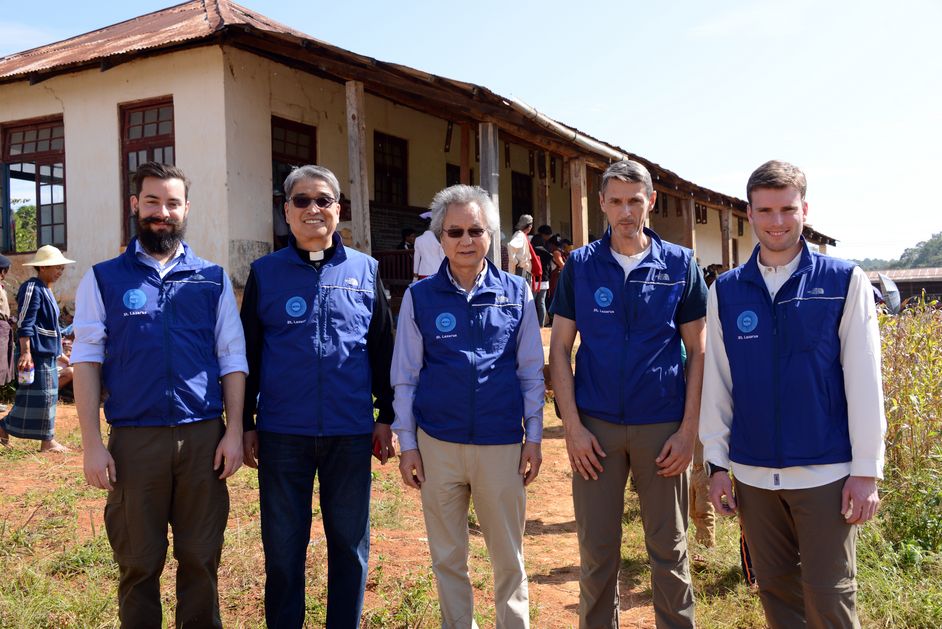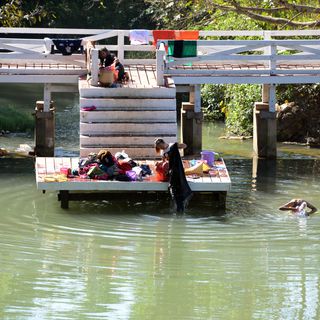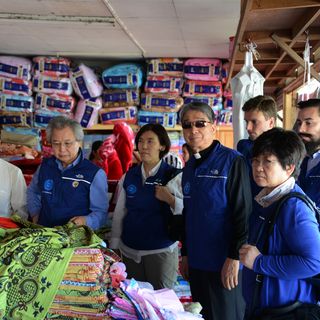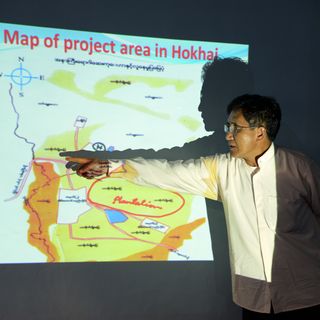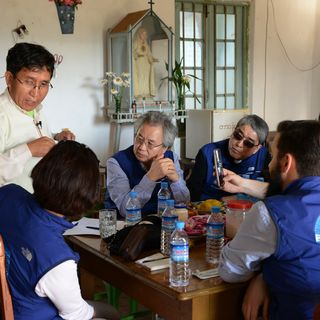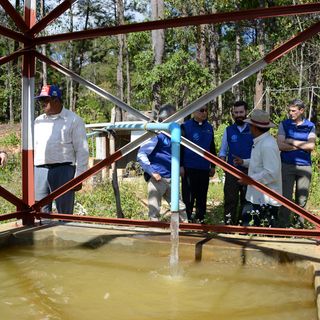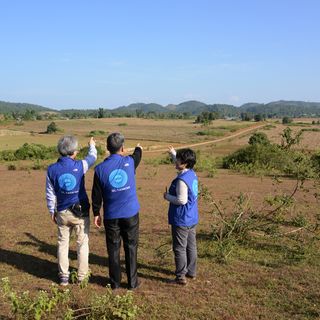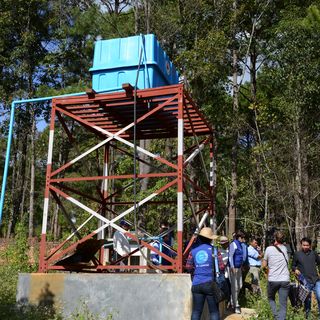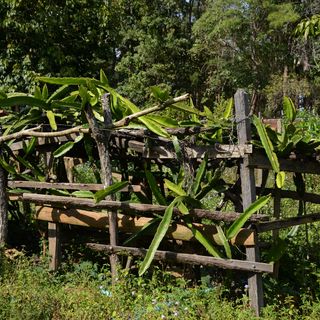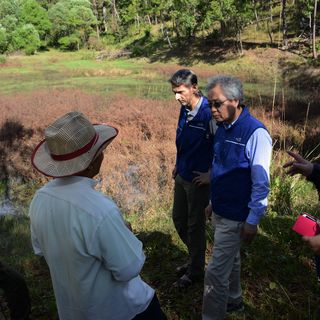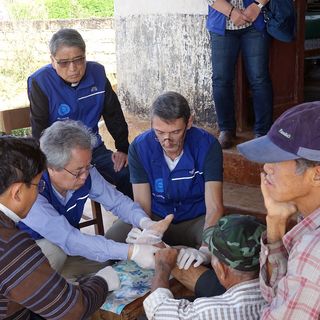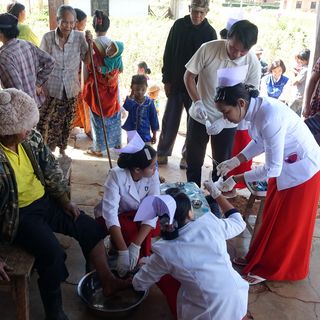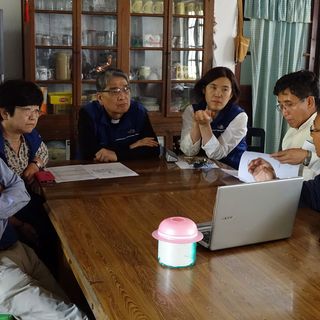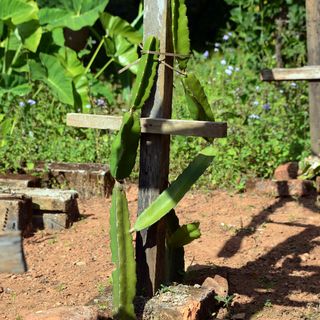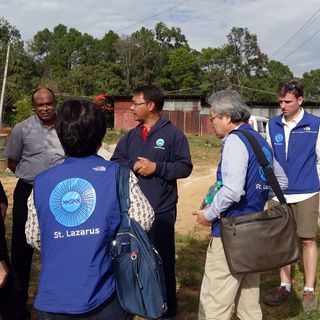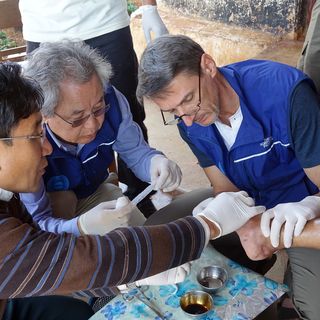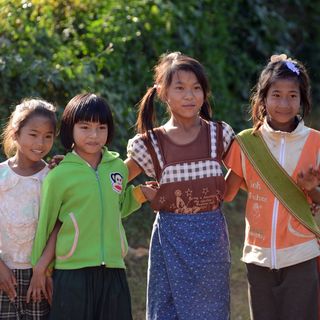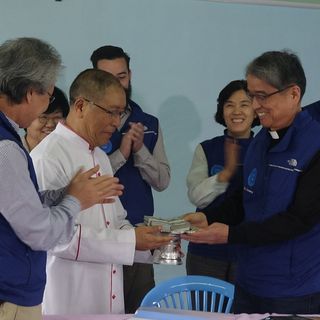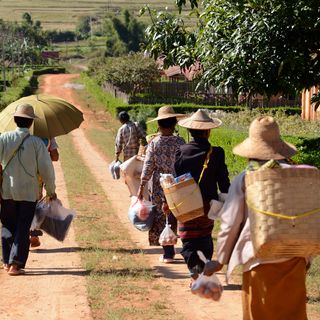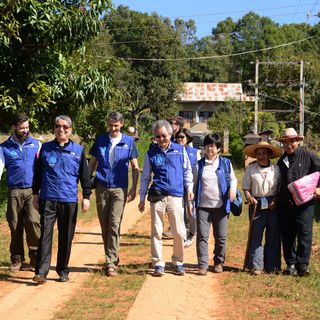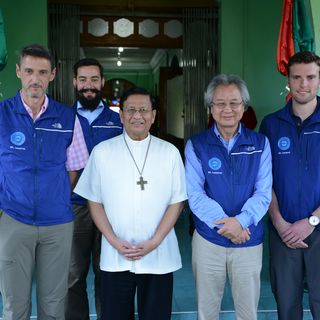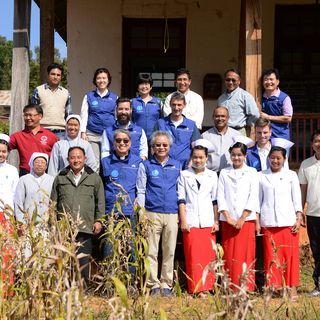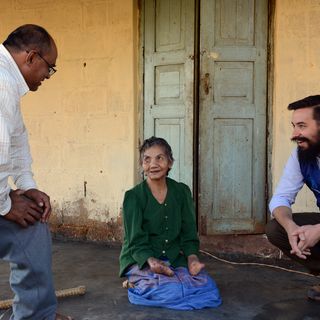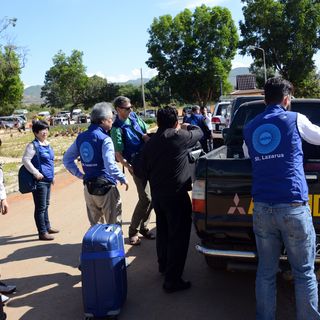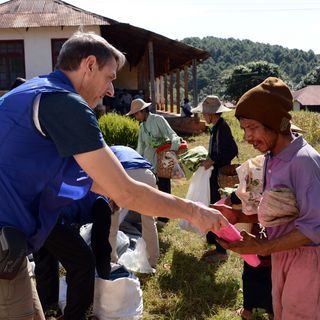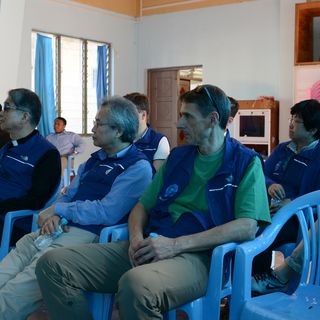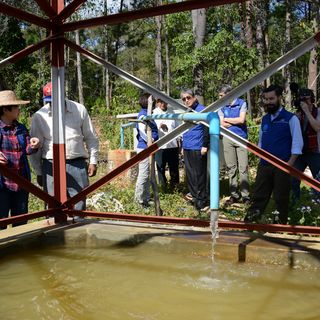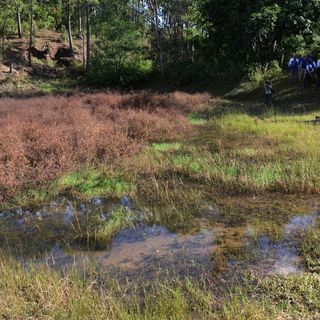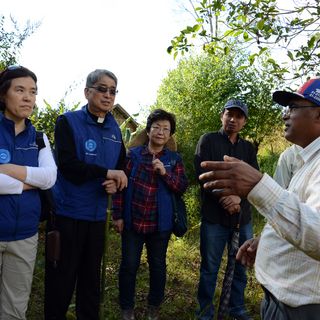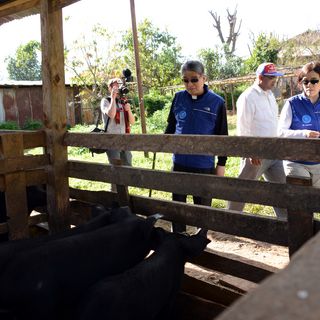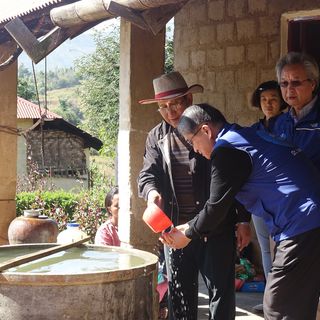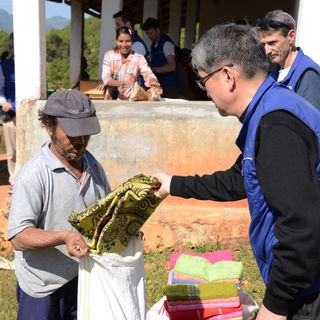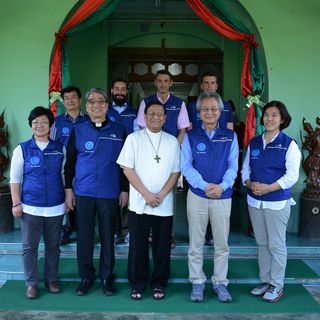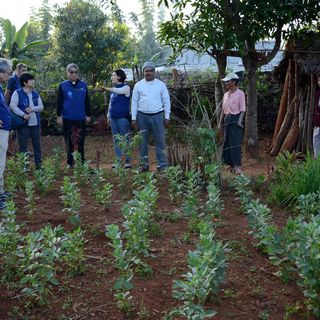2015: Loilem, Myanmar
A trip to Burma, which has been officially known as Myanmar since 1989, and particularly to the remote regions of that country, remains a minor adventure even today.
Hyung –Kun Peter Chung, Thomas Gille, Lukas Weil, Daniel Tögel, St. Lazarus -Fonds Europe e.V.
Travelling to the Leper Colony Loilem, Myanmar
A trip to Burma, which has been officially known as Myanmar since 1989, and particularly to the remote regions of that country, remains a minor adventure even today. We went there on November 27th, 2015, representing the St. Lazarus-Fonds Europe. The flight left from Frankfurt, and travelled via Bangkok. One day later a delegation from our sister organization St. Lazarus Korea arrived on a direct flight. We met in Yangon (Rangoon), a city in the south which was once the capital and remains the most important city in the country. The two delegations wanted to make plans together with those responsible for the Myanmar Agriculture and Life Support Project (MALSP), which supports the leper colony Loilem in the province of Shan.
We arrived late in the evening in Rangoon (time difference to Germany: +5 ½ hours). From our taxi, in addition to the hectic traffic conditions in the teeming metropolis, we could see innumerable construction sites of all sizes. These are a sign of the upheaval which followed the opening of the country a few years ago, after decades of complete isolation under the military dictatorship. The population is placing great hope on the Nobel Peace Prize winner Aung San Su Kyi, whose party was able to gain a clear victory in parliamentary elections in early December 2015. However, the military continues to exert a strong influence.
Due to the completely obsolete traffic infrastructure longer journeys in the country, which has about twice the area of Germany, can only be made by airplane within a reasonable period of time. Early the next day, after the issuance of a hand-written ticket, we took a propeller machine from a turbulent, old-fashioned air terminal to Heho, with an interim stop in Bagan. Heho is about 700km north of Rangoon. The baggage handling there is done by hand on a loading ramp of the small airport building, which contains the arrival and departure areas, check-in, luggage handling, police and customs. The security checks were rather perfunctory.
We were greeted by Father Peter Than, the regional manager for social services for the archdiocese of Taunggyi. After the preliminaries we headed off from the airport to our accommodations in the priest’s house in Taunggyi, a town of about 200,000 persons around 1400m above sea level. The hour-long, winding drive over bumpy roads was an adventure. Many small sales stands built of wood and corrugated iron line the dusty gravel road in a disorderly manner. Often people live in these poor huts, right on the edge of the traffic, and use open fires, nothing more than a small campfire between two bricks, for cooking. The landscape here is purely agricultural, with small forested steep hills and is very sparsely populated.
In the priest’s house at Taunggyi, which also serves as the official residence of the Archbishop, we received a generous meal with a varied offering of meat, fish, vegetables, and of course rice. Afterwards we had a first meeting with Father Than and his working group as well as with the project leader for the MALSP, the assistance project for the leper colony which St. Lazarus is financing. On the recommendation of Father Than, we then purchased 80 towels and 50 blankets at a local store as an immediate measure to improve living conditions for the sick in Loilem,.
The Myanmar-Agricultural and Life Support Project (MALSP): to date the roughly 800 inhabitants of the colony are dependent on the expensive purchase of food in large quantities, with the exception of small amounts of vegetables, fruit, and grain which is grown locally. The food purchases are financed by “Caritas Korea”. Since this supply is secure at a modest level, the project shall include the following sections:
Setup of plantations for avocado, mango, and dragon fruit. This will have an area of 12 hectares. The crops will be for consumption by the colony, and the excess will be sold.
Purchase of young cattle and their breeding in new stalls which have yet to be built, such as for:
30 pigs, which will be used by the colony later, or sold for a profit in regional markets.
Construction of a large fish pond, with room for 20,000 fish. A good return can be expected within a year, because the fish grow quickly.
In all these projects the inhabitants of the leper colony will be involved in the planning, execution, and particularly in the continuing management of the plantations, the fields and the animals. This will be done through the formation of working groups under the leadership of the inhabitants themselves. In addition to the social-economic improvements and the strengthening of the colony’s independence from food purchases, the goal is to give a boost to the leper’s self-esteem and autonomy.
The execution of the MALSP is the responsibility of the social organization KMSS from the archdiocese of Taunggyi, which provides the support for the leper colony. The progress of the work, the building of working groups, and also the instruction managed by agricultural experts will be reported quarterly. Additionally, the local representative of the St. Lazarus-Fonds, who lives in Myanmar, will report at regular intervals on the developments in the whole project. This ensures that the $80,000 which is being provided by St. Lazarus-Fonds Europe and St. Lazarus-Fonds Korea to cover the costs of the MALSP is used appropriately and directly benefits the leper colony Loilem.
In order to better view the situation and to judge the viability of the MALSP project on site we travelled from Taunggyi onwards to Loilem. This involved a drive of about three hours on narrow, poorly maintained country roads.
Traffic in this very mountainous region often consists of uncountable mopeds or shaky scooters, just as elsewhere in the country. They are often loaded with three to five riders or towering piles of luggage.
As well as the mopeds there are many small trucks, whose cargo area has often been converted to passenger transport or are hopelessly overloaded with sacks and packages. Overall the traffic seems completely deregulated. Traffic signs are scarce, place names are missing and there are daring overtaking manoeuvres. These last are communicated with unusual turn signals or blinking of headlights.
On our arrival in the small town of Loilem in company with Father Peter Than – the regional manager of all leper institutes for in the diocese of Taunggyi – we were greeted by Archbishop Matthias and then accompanied by the local priest about five kilometres to the St. Joseph leper colony Loilem. Viewed from a distance, the colony is situated in an attractive location between wooded hills. The colony now consists of five separate villages. It is managed by Father Alfred, a catholic priest with Indian roots, together with four nuns. They are supported by many helpers from the group of lepers. The welcome in the extremely modest priest’s house was very hearty – people are obviously very thankful that those in the colony will receive assistance. During the following days on site we were well looked after, by local standards, by the nuns.
On our first day in the Loilem colony we were able to view a pump and water tank facility which was financed by St. Lazarus-Fonds Korea. This was a first step in supplying the residents in the main village. However, the water is not drinkable, so a multi-step, but relatively simple filter will be installed. Once this is done the water can be stored in a new, not yet built tank, and then distributed to each house with pipes.
Two additional water production and storage facilities will be built. The first will be financed by St. Lazarus-Fonds Europe, the second by a generous individual donation. Both will be set up in the coming months. The costs for each well and distribution network are around $11,000.
We also looked at the site for the proposed fish pond for the MALSP project. This is a marshy area on low-lying ground where water gathers in the rainy part of the year. In order to use it as a fish pond it must be significantly deepened and secured against uncontrolled water loss. The colony members who will look after the fish production will be schooled in seminars to ensure a long term success. The pool area must be fenced in and guarded in order to prevent poaching by people from the neighbourhood.
The new stalls for the 30 pigs will be erected close to the village, replacing an existing, much too small, and dilapidated stall.
In the course of the village tour we saw the warehouse, during which Father Alfred explained the distributions for the lepers and those family members who have moved to the colony.
While visiting the kindergarten we saw children sitting on simple benches, who happily and loudly recited the alphabet, followed by the numbers 1-10. The very poor furnishing of this simple stone building was conspicuous – it consists simply of a few wobbly wooden benches and tables. There were a few pictures on the stone walls. Father Than spoke of the importance of toys for the children – even a simple toy push car would constitute an event here. The playground on dusty red-brown soil consists of a few old car tires set into the ground, on which the mostly barefoot children can play. In spite of all this the children seemed happy and not discontented.
The visit to the lepers themselves, who live alone or in groups up to four persons in simple stone houses roofed with corrugated iron, without water or electricity, illustrated the whole tragedy of leprosy. Crouching on the bare floor, or on wooden beds with a small cupboard as the only other furnishing, the inhabitants could be seen to suffer from extreme signs of advanced leprosy. This includes loss of limbs, immobility through paralysis and facial disfigurement, blindness and deafness. These patients have often succumbed to lethargy and resignation, while other, less seriously ill patients appeared happy while doing minor work in their homes. As much as possible, the house community prepared their own food on a simple campfire on the ground behind the house, while the seriously handicapped residents were supplied with food by the nuns. After a final discussion of the project stages so far we headed back to Loilem, where we spent the night on the property of the priest’s house there on cell-like rooms with blank walls on simple wooden cots. As a special treat the travellers received a bucket of hot water placed before the door the next morning, so that the existing cold tap water in the room could be brought to a more comfortable temperature. At night the temperature at this time of year could fall down to 10°C. Generally, in large parts of Myanmar, as in our quarters, there is no heating in houses or individual rooms.
On the morning of our second day in the leper colony Loilem the weekly issuance of food and items for daily use took place, things such as soap and toothbrushes. Those inhabitants who are able to walk came directly to the issuance, while volunteers delivered these items to those who were not able to come themselves. Later roughly 10kg of rice per person was issued. On this occasion we distributed those items which had been purchased on the suggestion of Father Than (towels, blankets, and also shoes). The inhabitants used these distributions for meetings and conversation, soon there was a lively atmosphere and some pairs of new shoes were exchanged. We could see the thankfulness in the people’s faces.
For lunch we were invited by the local priest in Loilem to a small pond, where he cultivates fish for his own consumption. Here as well a generous meal was prepared with simple means. On the way back Father Than showed us the surrounding area from a small hill. We could see the various fruit plantations and fields belonging to the project. We could also see that the colony has sufficient land to make all the individual aspects of the project possible. Additionally, Father Alfred explained that the colony’s properties must be used either for agriculture or forestry, because otherwise unused land will be confiscated by the government (which in this case would mean the military).
A further tour led us to a village in the colony which is mostly inhabited by Buddhist lepers who so far have not accepted supervision under Christian leadership. The result is that recommendations to improve conditions have been ignored and many children have been sent begging, rather than to school or kindergarten. Father Alfred explained that the inhabitants have been much more open-minded lately and are cooperating better. This village will also be the site of another well system for drinking water and general use, also financed by the St. Lazarus-Fonds Europe. In one of the wooden huts on stilts we met a couple who made it clear that the inhabitants of this part of the colony hoped for a significant improvement in their conditions from this well. To date water has had to be carried in buckets over considerable distances, which was very difficult for the weakened people and their children.
During the drive back to the priest’s house in Loilem and during the evening meal we discussed in detail the impressions of the day and the realisation of the MALSP project. The professional planning and execution by those on the site was very clear and made a deep impression on us.
On the third day the attending doctor from Loilem was expected. He visits the colony once a month. This put the medical cares of the lepers in the focus of our days activities.
Long before the doctor arrived the first patients had already arrived at the village infirmary. After a patient wait basic examinations such as blood pressure and fever checks were made by the nuns while Sister Catherine, who has been living and working with lepers for a long time, distributed medicine to treat acute complaints such as pain, fever, or high blood pressure. The sister keeps careful records of this distribution. The infirmary facilities consist of a room with simple, well-used furnishing. Everything shows signs of much use, there are only a few worn medical instruments which are cleaned after every use by putting them in boiled water, or at least disinfected as best as possible. The local doctor from Loilem arrived with four nurses and gave a short talk on leprosy. He mentioned simple things like hygiene for the hands and abstinence from alcohol. Afterwards he started treating the open wounds of the lepers. These wounds can easily develop out of small injuries due to the loss of sensibility in the hands and feet which comes from the disease. Some of us assisted actively in cleaning and applying fresh bandages on these wounds which were often as large as the palm of a hand and deep. They were particularly on the feet, which are often missing the toes and are damaged by leprosy. The patients were very pleased to be assisted by new helpers from the travelling group.
Early that afternoon two members of the local security forces arrived and warned about the fighting against rebels about 15km away. We were more or less instructed to leave the area immediately and had to end our visit to the leper colony abruptly. The visits planned for the next day and the joint church service had to be cancelled. We left in the fading evening light back to Taunggyi again, which is a comforting safe distance from the disturbances in Shan province.
On our last day in the area we presented Archbishop Matthias the amount of €10,000 as start capital for the agricultural project. He received this with gratitude and pleasure.
Afterwards we started our return trip by plane from Heho to Yangon, where we had an audience with Cardinal Charles Bo. He was only named to this position this year, as the first bishop in Myanmar to be called to the College of Cardinals by Pope Francis.
In the reception room, where no shoes may be worn, we were very cordially received by Cardinal Bo, who was also without shoes. In an almost hour long discussion we spoke at length about the situation of Christians in general and particularly since the political changes in Myanmar. The conditions in the different leper villages in the country was discussed and also our big project for the colony in Loilem. Cardinal Bo was very impressed by the activities of the groups from Germany and Korea and promised intensive care from the local priests and their helpers, in order to make a lasting improvement to the lives of the lepers and their families. With this in mind, Cardinal Bo from Yangon, Myanmar wished success for the benefit concert of the St. Lazarus-Fonds Europe on January 23, 2016, and that the financing of the project would be secured by generous donations.
Accompanied by this good will and with many lasting memories and experiences we travelled from Yangon back to Frankfurt and Seoul.
